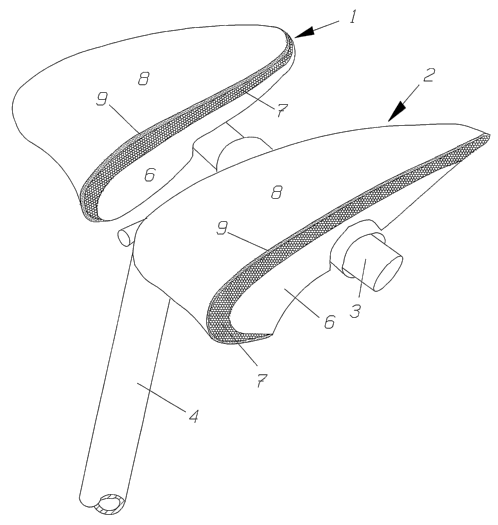Note: Descriptions are shown in the official language in which they were submitted.
CA 02557715 2006-08-28
WO 2005/085051 PCT/SE2005/000303
1
BICYCLE SEAT
The present invention relates to a bicycle saddle consisting
of two separated support~portions, each one for supporting one
of the bicycle rider's seat bones,~(upper femur), the two sup-
port portions being mounted on a joint bar, which is arranged
perpendicular to the central plane of the bicycle.
Bicycle seats of this kind are known from e.g. US 4 387 925
and w0 00/09386.
The object of the present invention is to reach to such a de-
sign of the bicycle seat that the support portions of the seat
will follow the movement of the seat bones when the rider's
thigh bones move up and down, that is to say when the rider
pedals his bicycle. The movement of the seat bone is three-di-
mensional, thus forward in the direction of the movement of
the bicycle, sideways and downwards. The specific object of
the present invention in relation to the known art is to de-
sign a bicycle seat which is very comfortable and includes as
few movable parts as possible and is adjustable to the bodily
constructional part of the rider.
An embodiment of the invention will be described in the fol-
lowing with reference to enclosed drawings.
Fig. 1 is a perspective view of the bicycle seat seen from
above from the front.
Fig. 2 is a perspective view of the bicycle seat seen from be-
low from behind.
CA 02557715 2006-08-28
WO 2005/085051 PCT/SE2005/000303
2
With reference to fig. 1 it is seen that the bicycle seat con-
sists of two support portions 1 and 2, which are arranged on a
transversal mounting bar 3, which on its part is supported by
a pool 4, which forms a part of the bicycle frame. The two
support portions 1 and 2 can be displaced sideways on the bar
3 in relation to each other by being mounted each on a sepa-
rate socket, which is slidable and rotatable on the bar and
can be fastened by a handle 5. That means that the inclination
of the support portions in relation to the horizontal plane
l0 can be adjusted and fixed by the handle 5. The two support
portions 1 and 2 shall be fixed in relation to the bar 3 when
the bicycle seat is used meaning that the two support portions
shall not be able to tip or being displaced sideways. The bar
3 can be mounted to the pool 4 in different ways known per se
and does therefore not form a part of the invention.
It can further be seen from fig. 1 that the surface form of
the support portions is such that they are wider at the for-
ward edge than at the back edge. Further, it can be seen that
the forward edge is round in order to give good comfort.
The advantage of the invention is now that each one of the
support portions will meet and follow the movement of the seat
bone without tipping or moving in some other way. Each of the
support portions is therefore designed according to the fol-
lowing. The support portions consist mainly of three super im-
posed layers. The undermost one of the layers is a bottom
plate 6, which can be fixed non turnable on the mounting bar
3, that is to say the bottom plate can not tip forward or
backwards when fixed. The bottom plate 6 is suitably made from
stiff sheet-metal. A second layer in the form of a cushion 7
is fastened to the bottom plate 6, the cushion being elastic
in all directions. The elasticity of the cushion 7 shall be
CA 02557715 2006-08-28
WO 2005/085051 PCT/SE2005/000303
3
such that it is never totally compressed when being loaded by
the rider but shall follow the movement of the rider's seat
bone, which movement thus is as well known downwards and some-
what sideways, which taken together obliquely downwards and
sideways. This movement is largest at the forward end of the
support portion. The thickness of the cushion in this area is
previously about 10 cm and the hardness is between 5-70 Shore
A. As can be seen from fig. 1 the thickness of the cushion is
decreasing in the backward direction.
A third layer 8 is laid upon the cushion, which layer 8 is
stiff in all directions in its plane. However, it should be
observed that fig. 1 and 2 show an intermediate layer 9 in the
form of foamed plastic but this layer is not necessary in or-
der to achieve the desirable effect but is something which may
improve the comfort. It should be noted that the three layers,
the bottom plate 6, the cushion 7 and the upper layer 8 are
united with each other via meeting surfaces by using some sort
of adhesive means. The layers should not be able to slide in
relation to each other.
Within the scope of the invention there are other embodiments
than the above described and this concerns specifically the
bottom plate and the upper layer 8. The bottom layer shall be
stiff and thus suitably formed from metal. The uppermost layer
8 can be of woven fabric, leather or even thin metal plate.
The elasticity of the cushion can be varied according to the
rider's weight but should be so dimensioned that it can stand
the weight of the person without being completely compressed
when the rider pedals the bicycle.
